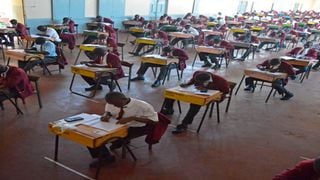
Students sit their Kenya Certificate of Secondary Education examination in 2017. Many children who join Form One do not make it to the examination.
| File | Nation Media GroupEducation
Premium
The scandal that is Kenya’s wasteful education system
Close to a million learners have dropped out of the education system in the last one year alone, and leaders fear the confusion over the new system of funding for those joining university or college could see more fall through the cracks.
This is despite government efforts to achieve 100 per cent transition across the several exit points, continuing the ritual of students not completing their studies.
Just recently, the government said it could not account for more than 500,000 students who sat the 2022 Kenya Certificate of Secondary Education (KCSE) tests after they failed to apply for admission to universities or technical and vocational education and training (TVET) institutes.
There is also a new concern that more out of those already placed might drop out, owing to funding complications after it emerged that only 75,272 out of the total 275,545 placed for tertiary education had applied for government funding, with just two weeks left to the closure of the applications portal.
This is 27.3 per cent of the First Year students.
Lawmakers on Thursday raised concerns over issues that may affect transition to tertiary education, with lack of financial support topping the list.
Education Cabinet Secretary, Ezekiel Machogu, said every student would be funded.
Official data, however, shows that over the years, a huge number of learners drop out of all levels of schooling, the highest number being after secondary education.
The number of those dropping out is not affected by increasing enrolment across the education sub-sectors.
According to data received by the Saturday Nation, approximately 300,000 learners who were in Grade Six last year did not join Junior School this year and 186,000 others who sat the Kenya Certificate of Primary Education (KCPE) examination did not transition to secondary school.
With the annual Sh1,420 per learner government funding for primary school, the amount translates to Sh690,120,000 spent on pupils for just two classes in one year who did not progress to the next level.
The amount is higher for junior school and secondary school, where the capitation is Sh15,042 and Sh22,244 per student respectively.
In our analysis, we compared the number of learners who enrolled in the beginner class of a particular level (primary, secondary, university) and those who completed.
According to the 2020 Basic Education Statistical Booklet, which is the latest, out of the 1,568,500 learners who enrolled in Standard One in 2013, some 318,405 did not get to Std Eight in 2020.

Higher Education Loans Board CEO Charles Ringera answers questions from journalists at State House in Nairobi on May 3 after the announcement of the new university education funding model.
This is a significant number, considering that it is for just one class. It is the class that was enrolled in primary school three months before Mr Uhuru Kenyatta and Dr William Ruto became president and deputy president of Kenya respectively.
Boys had the poorest completion rate at 79.7 per cent while 86.2 per cent of the girls survived to the last grade of primary education.
Also Read: The evolution of Kenya’s education system
This is the class that will open for its last term of Form Three next week and sit the KCSE examination in 2024.
“The survival rate was high for Standard Six as compared to Standard 8, the final grade of primary education.
“It implies that efficiency of the education system was better up to Standard Six but ly declined in the last two grades of primary education,” the document reads.
Many reasons, among them – teen pregnancies, death, lack of school fees and failure by parents to prepare children to attend school – are adduced for the dropping out.
The primary school completion rate appears better than that of secondary, which has the biggest wastage.
The number of learners who completed lower secondary (Form One and Two) in 2015 was 87.6 per cent while those who went all the way to Form Four was just 47.7 per cent. The projection by the government is to improve this to 57 per cent in 2025 and 64.5 per cent in 2030.
“Even after implementing free primary education and beginning to undertake free day secondary education, we hesitated on tertiary and higher education. Over the years, millions of Kenyans were left at home after failing to secure admission to tertiary education institutions,” President William Ruto said recently during the launch of the Open University.
There is no accurate data on transition from secondary school to tertiary level training for more than half of the students who leave Form Four.
Whereas the government has data on the students who are placed in universities and mid-level colleges, there is little information on where hundreds of thousands go after their KCSE examinations.
There is no system in place for tracking the progress of students who join university and college.
“The trend has been that we only have data for about a third of those who sit the examinations. We lack centralised data that can help us account for young people so that...we can actually tell where they went; whether to university, TVET, the Kenya Medical Training College, security forces or the National Youth Service,” said Kenya Universities and Colleges Central Placement Service Chief Executive Agnes Mercy Wahome when releasing placement results recently.

Ministry of Education officers use the National Education Management Information System to verify details of Form One students at Kakamega Boys High School on January 7, 2019.
Unlike in the past when the government used to keep records of students studying abroad, it currently does not have a way of identifying those who go to other countries, those who join private colleges as well as those who drop out of the education system.
A recent report by the Unesco on the progress made by countries towards their achievement of Sustainable Development Goal 4 projects said close to 35 per cent of Kenyan secondary school students will not complete upper secondary education by 2030.
“The main conclusion is that even if countries achieve their voluntarily set benchmarks, they still fall short of the SDG 4 target pledges, even before taking the potential impact of Covid-19 pandemic into account,” reads report titled National SDG 4 benchmarks: Fulfilling Our Neglected Commitment.






